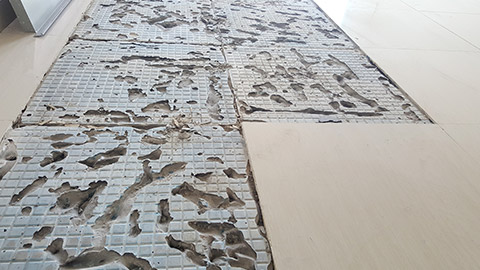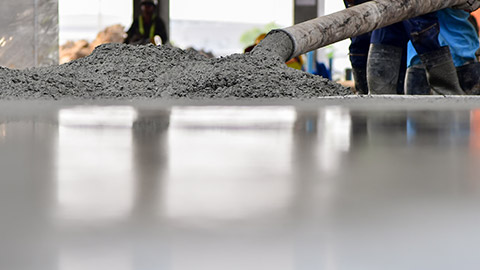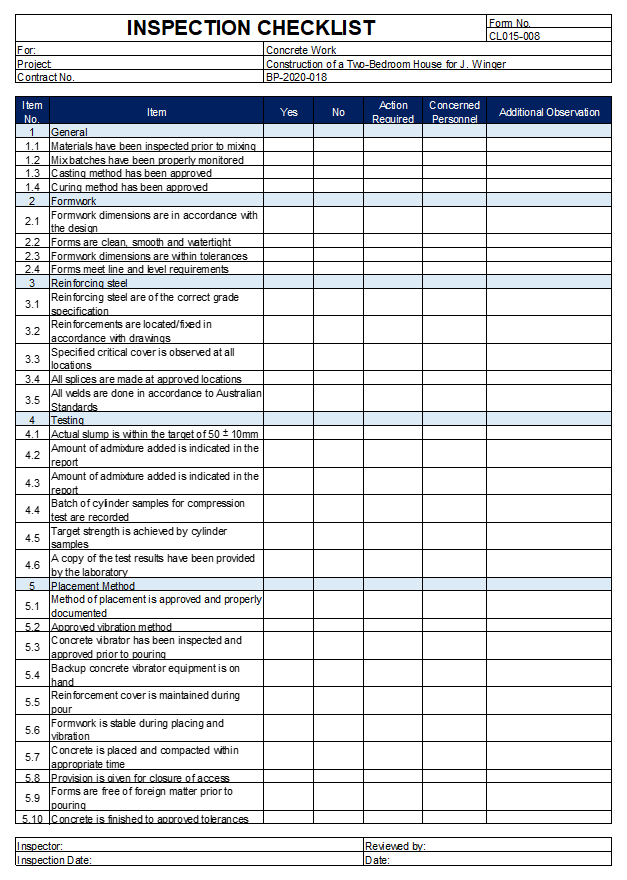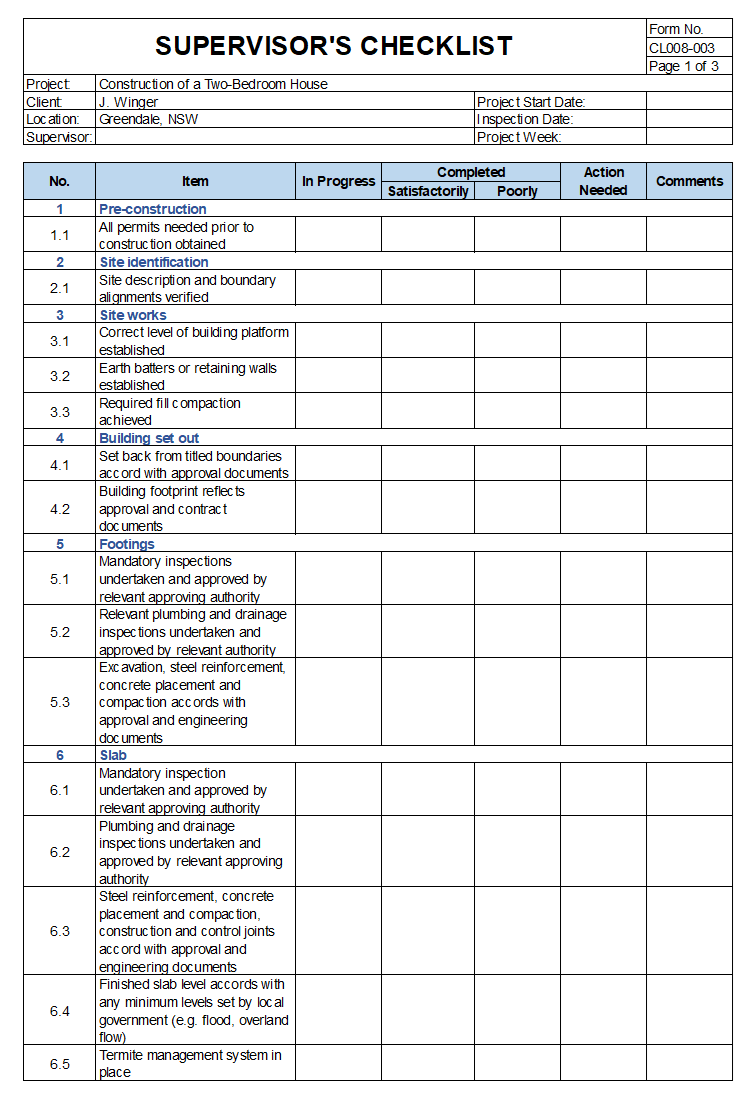The execution of quality control procedures in a construction project is only as effective as the communication between all personnel involved. Workers must be well-informed of the quality expected of their work as well as of the processes implemented by the management to achieve such conditions.
The organisation chart may be different for every company, but in general, construction work will be distributed according to this framework.
Here is a typical organisational chart for a construction project:
- The project manager will be in charge of the overall project execution.
- The WHS manager will be primarily overseeing the implementation of WHS Procedures.
- The site supervisor will directly be in charge of the leading hand or foreman, who will, in turn, be in charge of the workers.
- The QA or QC team, under the leadership of the QA or QC manager, will oversee QA or QC procedures.
- The contract administrator will manage administrative work related to the project contract.
- The project engineer will watch over design implementation.
- The QA or QC manager will primarily be responsible for the procedures related to quality control.
To effectively disseminate information after you have identified the requirements and outlined the quality control processes, you need to:
- Identify what information you need to convey and where you get them from
- Identify who you want to relay this information to
- Keep the information simple and easy to understand
- Use available means of communication to make information more accessible.
Identify key information
The first step to effective information dissemination would be to work with what you have on hand. In general, the following documents provide information on quality control processes and industry requirements:
- Quality Manual
- Quality Management Plan and associated documents
- Quality Checklists
- Contract Specifications
- Standards and Codes.
After going through the contract specifications, codes and standards, you need to consult with the company’s specific quality management policies. You need to identify then which information would be relevant and condense this information; otherwise, you will only be bombarding the site personnel with information that may be unrelated to them.

For example, a worker tasked to lay down reinforcing steel would not necessarily need to know the tensile strength requirement for the reinforcements. On the other hand, the procurement team would not need to know the client-required layout of reinforcements; however, they would need to know the technical specifications of the reinforcing steel in order to purchase the correct material.
Identify key personnel
As previously mentioned, the information you have gathered will only be useful to specific people to a certain extent. Therefore, you would need to categorise the information according to whether they are relevant to everyone or to a particular group of people only.
For example, the company’s quality manual contains standard operating procedures that need to be communicated to all personnel on-site; however, the quality control processes related to masonry would only be relevant to the people who are assigned to work on masonry and related trades.
KISS - Keep the Information Short and Simple
As you would be working with a diverse set of people onsite, it is important to present the information regarding quality control processes and industry requirements in a clear and concise manner. Keep sentences short and simple so that everyone would be able to read them quickly and understand them easily. Also, make use of simple diagrams and flowcharts to outline quality control processes. You may also collaborate with engineers and administrators to ensure the coherence of the information you want to present.
Choose communication methods
Lastly, you need to maximise the use of available means of communication on-site. You may opt to communicate necessary quality control processes and requirements through verbal communication, printed materials (memorandum, etc.), email, phone calls, and, if necessary, instant messaging alerts.
For quality control processes and requirements, it is important to provide documents and references that the personnel on site can easily access and go back to. In this regard, printed materials (such as memoranda and letters) and other means that can easily be documented (like emails) are preferable.
You may supplement these means with verbal communication and phone calls to highlight necessary information and deliver them quicker. Instant messaging applications may also be useful in sending quick alerts and useful links regarding quality control processes and requirements.
Before disseminating information on quality requirements, developing comprehensive quality control processes is fundamental.
Identifying the requirements and informing the construction team about them will not be enough to guarantee that the on-site work meets the quality standards set by the client or by regulatory codes and bodies. Achieving quality work would require a systematic development of quality control processes. In general, quality control process development may be outlined in five steps:
Step 1 - Analysis
The first step to developing an effective quality control process is analysis. This part is where you identify the requirements and standards that need to be attained for a specific project. Apart from the contract and national codes, you would also need to check state, territory and local legislation and consult with local councils to know the regulations you need to comply with for this project.
After the requirements have been made clear, you need to consult with the company’s policies regarding quality control. Usually, a construction company already has existing quality manuals and quality management plans. You will have to study these documents and use them as guides for organising your plans for quality control processes.
Quality Manual
A quality manual overviews a company’s Quality Management System (QMS). It provides context on a company’s line of work and shows its commitment to delivering quality products and services. It addresses the risks associated with a company’s operations and provides mitigation processes through management solutions. It shows potential clients and assessors that a company has an effective management system. It is usually aligned with the requirements of ISO 9001.
A quality manual typically covers a company’s policy statement on quality, objectives in terms of quality management, and standard operating procedures.
Quality Management Plan (QMP)
While quality manuals are designed to cover quality management for the general operations of a company, quality management plans are developed to outline how a company would execute quality management for a specific project. QMPs highlight practices and procedures related to project quality, summarise project deliverables, and outline organisational responsibilities.
QMPs are normally developed by the contractor before the commencement of construction as a requirement during the tendering stage. The contractor is then expected to execute quality control for a specific project after the general provisions in the QMP are submitted during preconstruction.
The following video refers to QMP as PQMP (Project Quality Management Plans) and provides you with further insight into quality management plans:
QMPs include the following content:
- Background on the project and scope of works
- Quality policies (may be aligned with a company’s quality manual)
- Standards applicable to the project
- Other contract requirements
- Organisational chart, roles, and responsibilities
- Contract change management
- Project activities and project control
- Project monitoring and inspection procedures
- Defect identification and rectification procedures
- Document control procedures.
Usually, the company’s quality control team would be responsible for the QMP and the bulk of the quality control procedures. However, as a supervisor, you need to be familiar with the QMPs to implement quality control on-site properly. Some organisations may also relegate the QC responsibilities to the supervisor for easier management. In such cases, knowledge of the company’s general policies on quality control will be extremely helpful.
Step 2 - Planning
After all details regarding quality requirements have been laid out, you need to map out the procedures for attaining these requirements. You may use the contents of the QMP as a guide for developing quality control procedures for the different construction work involved in a project. While developing your plan, be sure to address the following:
What construction materials will be used in this project?
One of the first items you must check for quality control is the materials supplied to the site. It is important to know the materials needed for the project so that you know what to look for in terms of quality control beforehand. The bill of quantities (BOQ) will be helpful in this instance. You will also need to coordinate with the procurement team for additional items not included in the BOQ.
What distinct construction tasks will be involved in this project?
You would also have to review the scope of work and identify the distinct construction work involved during project execution. A general building project would generally require the following work: excavation, foundation work, formwork, concrete work, framing (timber, steel, or reinforced concrete work), fit-outs, masonry, plumbing, insulation, HVAC installation, and various finishing work (plastering, tiling, coating application).
Who are the people responsible for the tasks?
It would be best to determine the people and trades involved in the specific construction work. This would help you distinguish which people to talk to when work-specific quality issues arise and would also help you delegate quality control tasks for every trade.
The table below shows the trades that often correspond to the construction work.
| Construction Work | Primary Trades Involved |
|---|---|
| Excavations | Excavator operator |
| Foundations | Piledriver operator, concrete mason |
| Formwork | Formwork carpenter |
| Concrete work | Concrete mason |
| Structural timber frame | Carpenter |
| Reinforced concrete frame | Concrete mason |
| Structural steel frame | Steel trades worker, welder, scaffolder |
| Floor systems | Floor installers and floor coating applicators |
| Roof system | Roof carpenter, sheet metal worker |
|
Masonry construction |
Bricklayer, stonemason, concrete mason |
| Curtain wall construction | Carpenter, bricklayer, stonemason, glazier |
| Building insulation | Insulation installer, carpenter |
| Finishing | Waterproofing installer, painter, plasterer, glazier, tiler, stonemason, coating applicators |
| Electrical | Electrician |
| Plumbing | Plumber |
| HVAC | HVAC installer, air conditioning mechanic |
What defining attributes indicate that the materials and work meet the requirements?
After determining the materials needed, the work involved, and the people responsible, you would have to determine the features indicating material and work compliance.
Compliance indicators may include documentation (evidence of suitability) such as Mill Test Certificates (MTCs) for structural steel or a Product Data Sheet (PDS) of a material stating that the properties of the material align with the requirements. Compliance indicators may be visually recognisable on the materials themselves, like the WaterMark logo etched or printed on a drainage pipe or the correct (as specified) paint colour.
Knowing features that make the material or finished work compliant with the quality requirements would help you develop necessary quality control checklists and inspection plans.
What defects are normally associated with the materials and works?

Apart from indicators of quality compliance, you would also need to be wary of signs indicating that a material or finished work is defective. For example, irregular dents and cracks in pipes and steel sections usually indicate that they are defective. At the same time, premature flaking and paint chipping are common indicators of improper surface preparation.
Knowing common defects associated with a certain material would help you easily spot a defective one out of a batch. Understanding the usual problems with construction work would be useful during inspection and in developing rectification plans.
How should these defects be corrected?
You would have to plan how the possible defects would be rectified in case they occur so that they may be fixed immediately. Correcting defects during construction is vital before they compound and cause unnecessary delays. Note that you are only planning for a quality control procedure, which is different from the rectification document required toward the project’s end.
For example, defective materials should not be used. Suitable materials should replace them. Painting damage caused by inadequate surface preparation would require the paint to be stripped off entirely and the surface preparation to be redone before repainting.
How should quality control monitoring be carried out?
In your plan, you should include how you intend to monitor the quality of work. You should include the inspection schedule, people concerned (roles and responsibilities), standard operating procedures, and external party inspection and testing schedules.
How should quality control measures be effectively communicated?
The quality control procedures would only be effective if the on-site communication is effective. You may include plans for quick meetings with the construction team.
Step 3 - Implementation

After you have identified what to look out for and have planned what to do about them, you would then have to implement the quality control procedures on site. During implementation, be sure to:
- Make use of the site checklists, plans and schedules - Be sure to use the checklists, plans and schedules developed during the planning stage. These would outline the action needed to conduct the inspection efficiently.
- Emphasise quality control processes during site induction - Site inductions ensure that everyone working on site will be well-informed of site regulations. Make sure to emphasise the quality control procedures that will be implemented.
- Coordinate with compliance assessors from external parties - As a requirement, the quality of the construction work will usually have to be checked and certified by external parties, such as a client-hired consultant and regulatory bodies.
- Maintain constant communication with clients - The client may opt to order variations and changes in the material or work specifications due to unforeseen circumstances. Changes such as these need to be integrated into the quality control process, and thus, it would be practical to maintain constant communication with the client.
- Record and document inspections and tests done - The testing and inspection results would eventually serve as evidence for compliance. Thus, it is important to have a well-organised documentation and recording system.
Step 4 and 5 - Review and Improvement
The development of quality control procedures is a continuous process. As the project progresses, some quality control procedures will be more effective. Circumstances and conditions in the construction site change as the project progresses. As such, the quality control processes must steadily be reviewed and improved. This can be achieved through the involvement of workers in the discussion.
Tradespeople involved in a particular construction work would have firsthand experience of quality control issues in their trade. They would be the best people to ask for input on avoiding these issues. Including the workers in the discussion would also proactively instil in them the changes in the quality control procedures, as they had input in the improvements made.
A site supervisor must know the construction project’s standards, construction code, contract, and jurisdictional requirements. After all these requirements have been met, a site supervisor must know the processes verifying project compliance. The supervisor must also know how to coordinate with appropriate authorities and certifying bodies to obtain official evidence of compliance.
This section will briefly revisit compliance and quality control requirements, discuss some jurisdictional variations, and focus on confirming these requirements are met.
Regulatory requirements
Regulatory requirements refer to those mandated by the legislation. Laws that apply primarily to building and construction include:
- Building Act 2004: The Building Act sets out the legislative framework for regulating building and construction activities in New Zealand. It governs the building consent process, building standards, compliance requirements, and the licensing of building practitioners.
- Building Code: The Building Code, established under the Building Act, sets out minimum standards and requirements for building design, construction, and durability. It covers structural integrity, fire safety, access, moisture control, and energy efficiency.
- Resource Management Act 1991 (RMA): The RMA addresses the sustainable management of natural and physical resources, including land use and development. It regulates activities that may impact the environment, such as land subdivision, earthworks, and resource extraction, and requires resource consent for certain projects. Reforms to this act are currently underway.
- Health and Safety at Work Act 2015 (HSWA): The HSWA aims to ensure the health and safety of workers and others affected by work activities, including those in the construction industry. It sets out duties and responsibilities for employers, employees, and other parties to manage workplace health and safety risks.
- Construction Contracts Act 2002: This legislation governs construction contracts' payment and dispute resolution processes. It provides mechanisms for progress payments, adjudication of payment disputes, and enforcing contractual rights and obligations.
- Local Government Act 2002: Local councils regulate building and construction activities within their jurisdictions. The Local Government Act empowers councils to develop district plans, issue building consents, and enforce building regulations at the local level.
Regional requirements
Local government in New Zealand are divided into regional council areas. These councils have jurisdiction over environmental management, natural resource management, land use planning, and regional infrastructure such as roads and public transport.
The following list indicates the government body that administers building work for each region.
- Northland Regional Council
- Auckland Council
- Bay of Plenty Regional Council
- Waikato Regional Council
- Gisborne District Council (also functions as a regional council)
- Taranaki Regional Council
- Hawke's Bay Regional Council
- Nelson City Council (also functions as a regional council)
- Manawatu-Wanganui Regional Council
- Wellington Regional Council
- Tasman District Council (also functions as a regional council)
- Marlborough District Council (also functions as a regional council)
- West Coast Regional Council
- Canterbury Regional Council (Environment Canterbury)
- Southland Regional Council
- Otago Regional Council
Beyond broader legislation, local city government may also mandate additional requirements from contractors and builders, especially with activities that may affect the community. This would pertain to local restrictions for building and construction, traffic management, planning activities, etc. Accordingly, builders and contractors must coordinate with local councils to understand the compliance requirements for their construction projects.
Violations of local policies and general legislation related to building and construction will have legal consequences (usually in fines). Thus, builders and contractors are expected to be knowledgeable of these requirements.
Organisational requirements
These requirements are implemented on the project to fulfil the specifications of the contract and external organisations. The quality of the construction work will have to be checked by external regulatory parties who may require the contractor to provide documentation and undertake procedures related to quality monitoring.
Meeting compliance and quality control requirements
For a construction project, it is not enough to implement processes that will lead to compliance with requirements. These processes must be well documented. New Zealand legislation requires the contractor’s claim of compliance to be validated by documentary evidence. While requirements may vary in different regions, evidence of compliance will typically come in the form of certificates.
Compliance certificates
Compliance certificates verify that a construction project or its elements meet the client’s and the law’s quality requirements. These certificates are issued by an external entity, usually an organisation accredited by the Joint Accreditation System of Australia and New Zealand (JAS-ANZ), a professional engineer, or an appropriately qualified person. Compliance certificates include:
- Construction Certificate
- Complying Development Certificate
- Plumbing Certificates
- Electrical Safety Certificate
- Glazing Certificates
- Termite Treatment Certificates
- Waterproofing Certificate
- Evidence and Certificate of Slip Hazards
- Fire Safety Certificate.
Before a certificate of compliance can be issued to a contractor, the external entity will have to execute a series of inspections or tests to assess the quality of construction work.
Testing results and reports
Other documents used to confirm compliance with requirements include test results and reports. These documents are especially significant in the technical assessment of the work or material and are issued by accredited testing laboratories or registered testing authorities. Test results and reports are also presented to the external certifying entities for their evaluation.
As a supervisor, you will need to coordinate with suitably accredited certifiers and testing laboratories, as well as with government authorities, to secure documentary evidence of compliance.

Watch the following video for an introduction to quality control inspections and testing plans.
What are inspection and test plans?
Inspection and Test Plans (ITPs) indicate when and how an inspection for a certain construction work will be conducted. As schedules for necessary inspections throughout the construction are laid out in them, ITPs are a good way to check whether the project is progressing as planned.
ITPs are usually part of the requirements submitted by the contractor to the client during the tendering stage. ITPs are generally developed by the quality control team. However, adjustments to the ITPs may be necessary during construction. As such, supervisors may be asked to provide input for ITP redevelopment.
How do inspection and test plans differ?
Inspection and test plans (ITPs) are closely related but serve slightly different purposes in construction projects. Here’s how they differ:
-
Inspection Plans:
- Inspection plans outline the specific checkpoints or milestones that must be inspected during construction.
- They specify what aspects of the work must be visually inspected to ensure compliance with project requirements, standards, and regulations.
- Inspection plans typically include details such as the location of inspections, the frequency of inspections, and the responsible parties.
-
Test Plans:
- On the other hand, test plans focus on the testing activities required to verify the performance and quality of materials, components, or systems used in construction.
- They detail the specific tests that need to be conducted, such as material strength, pressure, or electrical tests.
- Test plans specify the testing procedures, acceptance criteria, and responsible parties for each test, ensuring that materials and systems meet the required standards and specifications.
How do you access the ITPs for a specific project?
It would be best to communicate with the people primarily responsible for developing the ITPs: the quality control team and the project manager. You may also have to speak to the designated document controller for documentation purposes. Normally, ITPs are included in the company’s QMP documentation.
How do you develop an ITP?
To develop an ITP, you will need to:
- Find a template. To make the process easier, find a template to pattern your ITP after. You may use the ITPs from your company’s previous projects as your template. You will have to adjust the contents of these templates to fit the current project’s specific requirements.
- List the key points for each construction work and the corresponding inspection method. Also, include milestone inspections.
- Refer to the project specifications, codes, and legislative requirements and note the required tests and inspection activities for each key point previously listed.
- Indicate the tentative date of the tests and the frequency of inspections.
- Take note of the people responsible for the inspection and test activities.
- Take note of the inspection and test deliverables.
Case Study: inspection for a two-bedroom house

Consider the section of sample ITP below. This portion of the ITP covers the plan for concrete work inspection. Companies usually have a standard format for ITPs, so you can assume that this follows the company’s ITP format. Next, some key points for concrete work inspection have been listed. For this portion, key activities identified are material inspection and concrete testing. Required tests are also indicated as per specification.
The ITP indicates the frequency of activities and the stage where they are expected to be implemented. The sample ITP also shows the personnel involved in the activities stated and takes note of the deliverables in the ‘Records’ column.
Construction checklists
The supervisor must utilise the checklists, plans, and schedules to oversee processes related to quality control effectively. To do this, the supervisor must be able to access these documents easily. The supervisor must quickly be able to coordinate with construction team members who are principally in charge of the development and record-keeping of these documents.
Consequently, when these plans, schedules, and checklists have to be realigned with the actual project conditions, the supervisor’s input will be important. Therefore, it is also necessary for the supervisor to be familiar with the development of these documents.
QC checklists for quality control inspectors
Watch the following video to learn about five ways quality control inspectors use QC checklists.
What are construction checklists?
Checklists track the efficiency and quality of construction work and materials by providing specific features indicative of compliance. While ITPs tell you what to do, checklists tell you exactly what to look for. Common checklists for a construction project work include:
- Safety checklists
- Equipment and tools checklists
- Material inspection checklist
- Pre-work checklists
- Project performance checklist.
How do you access project-specific checklists?
As with ITPs, checklists may be accessed by communicating with the person responsible for the checklist development. For example, the WHS team will primarily be responsible for detailed safety checklists, while the QC team will be responsible for the quality control checklists for work and materials. Checklists are also normally included in the QMP documentation for a project.
As a supervisor, overseeing the workers will have both safety and quality control aspects. Thus, you may need to develop your checklist to cover both aspects. In doing this, you will have to use the contents of WHS and QC checklists and integrate them into a checklist more suited for your job.
How do you develop construction checklists?
Generally, developing construction checklists will require you to do the following:
-
Identify what your checklist is for. Keep in mind what the checklist is for and stay within that scope. For example, suppose you need to develop a quality control checklist for window installation. In that case, you will only need to put items on the checklist that are directly related to window installation quality. You will not need to include whether the installers are wearing proper PPE. This will be noted in a separate WHS checklist.
-
List down the attributes that will indicate the material/equipment/work requirement compliance. For example, glass windows free of scratches and cracks are one of the indicators of proper installation. Next to the items, add columns that will reflect the conditions of the items (i.e. completed, defective, etc.).
-
Include deliverables in your checklist. Whenever applicable, indicate the documentary evidence associated with a checklist item. For example, a checklist item corresponding to material testing should have an output as a test result document.
-
Categorise the items in your checklist. You may opt to arrange items chronologically, by trade, or in any order that will help efficiently use the checklist.
-
Make sure the contents of the checklist can easily be understood. The checklist may be reviewed and used by other team members or in further assessment activities. For efficiency, keep the language concise.
-
Assess and update your checklist. Ensure the items in your checklists are updated with any change in the requirements implemented during construction.
Case Study: inspection checklist for concrete work

Consider the following sample of an inspection checklist to assess the quality of concrete work.

The items listed are directly related to concrete work only. Notice that although the materials and equipment used for concrete work need to be inspected, the checklist does not cover them in detail, as they are outside the scope of the checklist. Instead, they are only referred to in the checklist as ‘inspected prior to’ items, e.g. 1.1 and 5.3.
- 1.1 Materials have been inspected prior to mixing
- 5.3 Concrete vibrator has been inspected and approved prior to pouring
Each item is an indicator of requirement compliance. For example, item 2.2 obliges to check whether the forms are clean, smooth and watertight. The columns to the right of the items indicate whether the condition has been achieved (‘Yes’) or not (‘No’). Space is provided to note required action, if necessary, and additional comments.
Additionally, you can see that deliverables have been included in the checklist. Item 4.6 indicates that a copy of the test result for the compression test must be obtained from the testing laboratory.
Notice that the items have been listed by work category: general items, formwork, reinforcing steel, and placement method. Language has also been kept concise for efficiency. Depending on the construction process changes, this checklist may be assessed and improved to fit the current condition.
Case Study: supervisor’s checklist
The supervisor will have to oversee the entirety of the construction work. As such, it will be helpful to develop a checklist that would itemise the general conditions expected of the project. The following is a sample of a supervisor’s checklist for a residential project. It has been developed to assess and ensure the necessary work and building components are properly completed. As you can see, the items are more general compared to the previous checklist.

From this example, the checklist covers the overall progress of the construction project, from pre-construction to the final stage. Items that will ensure good quality of work and requirement compliance have been listed. The checklist also has columns indicating whether the items have been completed satisfactorily or poorly or are currently in progress.
The checklist also features important documentation such as permits (Item 1.1) as well as mandatory inspections (Items 5.1, 5.2, 6.1, 6.2). Items have been listed chronologically according to how the work will progress onsite. This will help the supervisor monitor the progress of the construction.
Additionally, the checklist has been worded and will make the progress inspection for a supervisor more efficient.
This checklist can be revised to add or edit items that will reflect any change in the project requirements.
Complete the following four-question quiz.
That's the end of module eight. Let's hear a summary of what we've covered so far.
Click 'Video Transcript' or the plus icon (+) to expand and reveal the transcript for the previous video.
Hey team, summing up our topic on Leading Quality Assurance in construction. First off, we explored how workplace quality control processes are like the superhero cape for your projects—keeping things top-notch. Then, we dived into your responsibilities and cool techniques to communicate those quality assurance requirements. Communication is key to a smooth operation, right? Next, we covered meeting compliance with the quality assurance process. Dot those 'i's, cross those 't's—let's keep things legit. And remember, if things don't hit the quality mark, we've got remedial action to the rescue! Thanks for joining the QA party! More insights and tips are on the way. Until next time, lead on and keep that quality game strong! Cheers!
